Family Stenostiridae (Fairy Flycatchers)
Stenostiridae is a family in the order Passeriformes. They are a group of small African and Asian flycatchers that were previously scattered across three superfamilies. They include the Fairy Flycatcher Stenostira (Sylvioidea: Sylviidae), the Elminia (Covoidea: Monarchidae) crested-flycatchers, and the Culicicapa (Muscicapoidea: Muscicapidae) canary-flycatchers. The last three Elminia were previously considered part of the genus Trochocercus in the corvid family Monarchidae.
Africa Wild Bird Book
Family Stenostiridae (Fairy Flycatchers) Index
Family Stenostiridae (Fairy Flycatchers)
Stenostira scita Fairy Flycatcher 706 https://africawild-forum.com/viewtopic.p ... 31#p196531
Elminia albicauda White-tailed Blue Flycatcher
Elminia albonotata White-tailed Crested Flycatcher
Stenostira scita Fairy Flycatcher 706 https://africawild-forum.com/viewtopic.p ... 31#p196531
Elminia albicauda White-tailed Blue Flycatcher
Elminia albonotata White-tailed Crested Flycatcher
-
Michele Nel
- Posts: 1994
- Joined: Mon Sep 10, 2012 10:19 am
- Country: South Africa
- Location: Cape Town
- Contact:
Fairy Flycatcher
706. Fairy Flycatcher Stenostira scita (Feevlieëvanger)
Order: Passeriformes. Family: Stenostiridae
Description
The Fairy Flycatcher is 11–12 cm in length. The sexes are alike.
Adult: Crown to rump uniform dark, soft, blue-grey, very subtly tinged olive. Lores, ear coverts and cheeks black (forming mask); bordered above by narrow white supercilia that meet on frons, and below by white malar stripe. Narrow white line ca 3 mm long borders lower eyelid. Rump appears white when flank plumes overlie rump feathers. Upper tail coverts bluish black. Tail glossy black. Belly whitish, centre of belly creamy white, feathers with striking pink bases, not always clearly visible. Vent and undertail coverts whitish. Bill black, slender; rictal bristles present. Eyes dark sepia-brown. Legs and feet black.
The juvenile is browner than the adult.
Similar species: It is similar to a slim batis, having a white wing bar and a black face mask, though the Fairy Flycatcher has much longer legs than the batises and a longer tail with white outer tail feathers.
Distribution
Endemic to southern Africa, with the bulk of its population scattered across South Africa, excluding the lowland coastal forests of the Eastern Cape and KwaZulu-Natal and extending marginally into southern Botswana and Namibia.
Habitat
During the breeding season it favours shrublands, such as Karoo, fynbos, thorny thickets, mountain scrub and sweet grassland. In winter it moves into more wooded habitats, including Acacia savanna, plantations and gardens.
Diet
It solely eats insects, often making short sallies from a perch to hawk prey aerially. It also joins mixed species foraging flocks, and it may glean insects from flowerheads. The following food items have been recorded in its diet:
Insects
Diptera (flies)
Hemiptera (bugs)
Coleoptera (beetles)
Hymenoptera (wasps, bees and ants)
spiders
Breeding
The female solely builds the nest, which is an open cup built of dry grass stems and other plant matter, such as slangbos (Stoebe), honeythorns (Lycium) and wild Asparagus. It has even been recorded using rags, rubbish and human hair, which it once attempted to pull from someones head! It is typically placed in the fork of a branch or against the trunk of a tree, especially Acacia. It may also use a dead tree stump or branch, or hiding it amongst dead aloe leaves. Egg-laying season is year-round, but peaking from September-October. It lays 2-4 eggs, which are incubated solely by the female for about 13-16 days. The female mainly takes care of the chicks, who stay in the nest for about 15-17 days, after which they still fed for unknown period of time. There is one strange record of a Cape robin-chat feeding a Fairy flycatcher's chicks with beetles then hiding when the parents arrived.
Call
The call is a short, sibilant trill kisskisskisskiss.
Status
Common endemic resident.
Order: Passeriformes. Family: Stenostiridae
Description
The Fairy Flycatcher is 11–12 cm in length. The sexes are alike.
Adult: Crown to rump uniform dark, soft, blue-grey, very subtly tinged olive. Lores, ear coverts and cheeks black (forming mask); bordered above by narrow white supercilia that meet on frons, and below by white malar stripe. Narrow white line ca 3 mm long borders lower eyelid. Rump appears white when flank plumes overlie rump feathers. Upper tail coverts bluish black. Tail glossy black. Belly whitish, centre of belly creamy white, feathers with striking pink bases, not always clearly visible. Vent and undertail coverts whitish. Bill black, slender; rictal bristles present. Eyes dark sepia-brown. Legs and feet black.
The juvenile is browner than the adult.
Similar species: It is similar to a slim batis, having a white wing bar and a black face mask, though the Fairy Flycatcher has much longer legs than the batises and a longer tail with white outer tail feathers.
Distribution
Endemic to southern Africa, with the bulk of its population scattered across South Africa, excluding the lowland coastal forests of the Eastern Cape and KwaZulu-Natal and extending marginally into southern Botswana and Namibia.
Habitat
During the breeding season it favours shrublands, such as Karoo, fynbos, thorny thickets, mountain scrub and sweet grassland. In winter it moves into more wooded habitats, including Acacia savanna, plantations and gardens.
Diet
It solely eats insects, often making short sallies from a perch to hawk prey aerially. It also joins mixed species foraging flocks, and it may glean insects from flowerheads. The following food items have been recorded in its diet:
Insects
Diptera (flies)
Hemiptera (bugs)
Coleoptera (beetles)
Hymenoptera (wasps, bees and ants)
spiders
Breeding
The female solely builds the nest, which is an open cup built of dry grass stems and other plant matter, such as slangbos (Stoebe), honeythorns (Lycium) and wild Asparagus. It has even been recorded using rags, rubbish and human hair, which it once attempted to pull from someones head! It is typically placed in the fork of a branch or against the trunk of a tree, especially Acacia. It may also use a dead tree stump or branch, or hiding it amongst dead aloe leaves. Egg-laying season is year-round, but peaking from September-October. It lays 2-4 eggs, which are incubated solely by the female for about 13-16 days. The female mainly takes care of the chicks, who stay in the nest for about 15-17 days, after which they still fed for unknown period of time. There is one strange record of a Cape robin-chat feeding a Fairy flycatcher's chicks with beetles then hiding when the parents arrived.
Call
The call is a short, sibilant trill kisskisskisskiss.
Status
Common endemic resident.
-
Michele Nel
- Posts: 1994
- Joined: Mon Sep 10, 2012 10:19 am
- Country: South Africa
- Location: Cape Town
- Contact:
Fairy Flycatcher Photos
706. Fairy Flycatcher Stenostira scita

Links:
Sabap2: http://sabap2.adu.org.za/spp_summary.ph ... §ion=3
Species text in The Atlas of Southern African Birds
Biodiversity Explorer: http://www.biodiversityexplorer.org/bir ... _scita.htm
Newman's Birds of Southern Africa
Wikipedia: http://en.wikipedia.org/wiki/Fairy_Flycatcher
SANBI

Links:
Sabap2: http://sabap2.adu.org.za/spp_summary.ph ... §ion=3
Species text in The Atlas of Southern African Birds
Biodiversity Explorer: http://www.biodiversityexplorer.org/bir ... _scita.htm
Newman's Birds of Southern Africa
Wikipedia: http://en.wikipedia.org/wiki/Fairy_Flycatcher
SANBI
Family Paridae (Tits)
The avian family Paridae (tits and chickadees) contains c. 55 species distributed in the Palearctic, Nearctic, Afrotropic and Indomalaya. The tits and chickadees are widely distributed, with 18 species in Palearctic, 15 in the Indomalayan and Afrotropical regions and 12 in the Nearctic. Collectively tits and chickadees occur in a wide range of habitats and can be found in virtually all wooded biomes.
The tits are extremely similar in appearance, and have been described as one of the most conservative avian families in terms of general morphology. The typical length of the family is between 10–16 cm in length. The bills of the tits are generally short, and vary between stout and fine dependent on diet. The more insectivorous species have finer bills, whereas those that consume more seeds have stouter bills.
In more recent classifications of Paridae, three genera have typically been recognized (Melanochlora, Sylviparus and Parus). Yet it has also remained common practice to divide the largest of these genera, Parus, into several subgenera. For instance, Harrap and Quinn (1996) recognized 10 subgenera (Poecile, Periparus, Pardaliparus, Lophophanes, Melaniparus, Parus, Machlolophus, Cyanistes, Sittiparus, and Baeolophus). Some of these subgenera have in recent years been elevated to genera. This arrangement was adopted by Gosler and Clement (2007) in their account of the Paridae for the Handbook of the Birds of the World. Although several aspects of this classification have been criticized, we make use of this classification and place the African tits (mostly having dark plumage) in the genus Melaniparus (separeted from the genus Parus). All Afrotropical tits are strongly supported as monophyletic, indicating a single colonization of this region. Recent data largely support this division (Ulf S. Johansson, Jan Ekman, Rauri C.K. Bowie, Peter Halvarsson, Jan I. Ohlson, Trevor D. Price, Per G.P. Ericson. A complete multilocus species phylogeny of the tits and chickadees (Aves: Paridae)).
The tits are extremely similar in appearance, and have been described as one of the most conservative avian families in terms of general morphology. The typical length of the family is between 10–16 cm in length. The bills of the tits are generally short, and vary between stout and fine dependent on diet. The more insectivorous species have finer bills, whereas those that consume more seeds have stouter bills.
In more recent classifications of Paridae, three genera have typically been recognized (Melanochlora, Sylviparus and Parus). Yet it has also remained common practice to divide the largest of these genera, Parus, into several subgenera. For instance, Harrap and Quinn (1996) recognized 10 subgenera (Poecile, Periparus, Pardaliparus, Lophophanes, Melaniparus, Parus, Machlolophus, Cyanistes, Sittiparus, and Baeolophus). Some of these subgenera have in recent years been elevated to genera. This arrangement was adopted by Gosler and Clement (2007) in their account of the Paridae for the Handbook of the Birds of the World. Although several aspects of this classification have been criticized, we make use of this classification and place the African tits (mostly having dark plumage) in the genus Melaniparus (separeted from the genus Parus). All Afrotropical tits are strongly supported as monophyletic, indicating a single colonization of this region. Recent data largely support this division (Ulf S. Johansson, Jan Ekman, Rauri C.K. Bowie, Peter Halvarsson, Jan I. Ohlson, Trevor D. Price, Per G.P. Ericson. A complete multilocus species phylogeny of the tits and chickadees (Aves: Paridae)).
Family Paridae (Tits) Index
Family Paridae (Tits)
Melaniparus carpi Carp's Tit 555
Melaniparus niger Southern Black Tit 554
Melaniparus rufiventris Rufous-bellied Tit 556
Melaniparus pallidiventris Cinnamon-breasted Tit
Melaniparus griseiventris Miombo Tit 553
Melaniparus cinerascens Ashy Tit 552
Melaniparus afer Grey Tit 551
Melaniparus carpi Carp's Tit 555
Melaniparus niger Southern Black Tit 554
Melaniparus rufiventris Rufous-bellied Tit 556
Melaniparus pallidiventris Cinnamon-breasted Tit
Melaniparus griseiventris Miombo Tit 553
Melaniparus cinerascens Ashy Tit 552
Melaniparus afer Grey Tit 551
- nan
- Posts: 26451
- Joined: Thu May 31, 2012 9:41 pm
- Country: Switzerland
- Location: Central Europe
- Contact:
Southern Black Tit
554. Southern Black Tit Melaniparus niger (Gewone Swartmees)
Order: Passeriformes. Family: Paridae
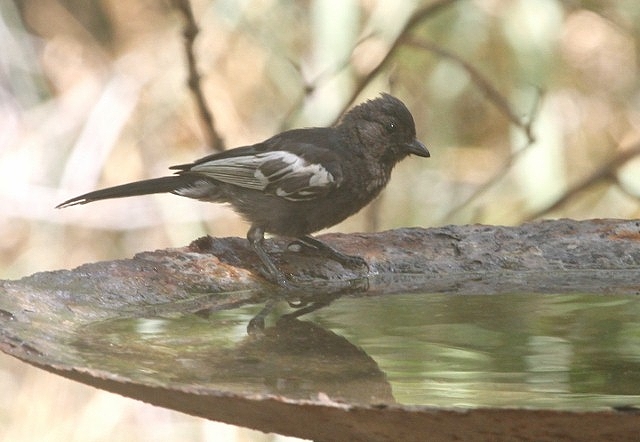
Female
Description:
Size 14-16 cm. The Southern Black Tit is almost entirely monotone in colour. Black bill and legs. Brown eye.
Adult male: Head, mantle, back and upper tail coverts glossy black. Tail black, edged and tipped white. Wings blackish brown, primaries, secondaries and tertials with white outer edges. Greater coverts edged white, median coverts white. Chin, throat and breast dull black, shading to grey-black on belly. Undertail coverts black, barred white. Bill black. Eyes brown. Legs and feet black.
Adult female: As male, but duller overall; face and underparts greyer.
Juvenile resembles female.
Similar species: Within the sub-region there are two ‘black tits’ and for the most part they are easily separable based on known distribution with the only overlap taking place in the very north of Namibia. As such the Southern Black Tit tends to favour the broad-leafed woodland in areas of higher rainfall to that preferred by Carp’s Tit, which is found in arid savannah and open thornveld along the eastern edge of the Namib Desert. Male Southern Black Tit has less white in the wings than Carp's Tit. Female Southern Black Tit differs from female Carp's Tit in being paler grey below and having less white in the wings.
Distribution
Occurs from Zambia and southern Angola to southern Africa. Here it is generally common across Zimbabwe, Mozambique, northern and eastern Botswana, north-eastern Namibia and South Africa, specifically in the Kruger National Park, KwaZulu-Natal and the Eastern Cape.
Habitat
Forest and broad-leaved woodland.
Diet
It mainly forages along the branches of trees, gleaning insects from bark and leaves but also eating nectar and fruit.
Breeding
Monogamous, territorial cooperative breeder, meaning that the breeding pair are sometimes assisted by up to 4 helpers. The nest is built solely by the female and consists of a thick pad built of grass, lichen and hair, or alternatively shredded Bobbejaanstert (Xerophyta villosa) leaves. It is usually placed in a cavity in the main trunk of a tree, but rarely in nest boxes. Egg-laying season is from August-January, peaking around September-November. It lays 1-6 white eggs, which are incubated solely by the female for approximately 14-15 days. She occasionally meets up with the other group members to go foraging - in one study the female spent an average 76% of the day incubating and 24% foraging. The female broods and feeds the chicks with food given to her by the male and group members. They eventually fledge at about 24 days old, but only start foraging 2 weeks later but eventually they can fend for themselves at about 75 days old.
Call
A harsh, chattering chrr-chrr-chrr and a musical phee-cher-phee-cher. Listen to Bird Call.
Status
Common resident.
Order: Passeriformes. Family: Paridae

Female
Description:
Size 14-16 cm. The Southern Black Tit is almost entirely monotone in colour. Black bill and legs. Brown eye.
Adult male: Head, mantle, back and upper tail coverts glossy black. Tail black, edged and tipped white. Wings blackish brown, primaries, secondaries and tertials with white outer edges. Greater coverts edged white, median coverts white. Chin, throat and breast dull black, shading to grey-black on belly. Undertail coverts black, barred white. Bill black. Eyes brown. Legs and feet black.
Adult female: As male, but duller overall; face and underparts greyer.
Juvenile resembles female.
Similar species: Within the sub-region there are two ‘black tits’ and for the most part they are easily separable based on known distribution with the only overlap taking place in the very north of Namibia. As such the Southern Black Tit tends to favour the broad-leafed woodland in areas of higher rainfall to that preferred by Carp’s Tit, which is found in arid savannah and open thornveld along the eastern edge of the Namib Desert. Male Southern Black Tit has less white in the wings than Carp's Tit. Female Southern Black Tit differs from female Carp's Tit in being paler grey below and having less white in the wings.
Distribution
Occurs from Zambia and southern Angola to southern Africa. Here it is generally common across Zimbabwe, Mozambique, northern and eastern Botswana, north-eastern Namibia and South Africa, specifically in the Kruger National Park, KwaZulu-Natal and the Eastern Cape.
Habitat
Forest and broad-leaved woodland.
Diet
It mainly forages along the branches of trees, gleaning insects from bark and leaves but also eating nectar and fruit.
Breeding
Monogamous, territorial cooperative breeder, meaning that the breeding pair are sometimes assisted by up to 4 helpers. The nest is built solely by the female and consists of a thick pad built of grass, lichen and hair, or alternatively shredded Bobbejaanstert (Xerophyta villosa) leaves. It is usually placed in a cavity in the main trunk of a tree, but rarely in nest boxes. Egg-laying season is from August-January, peaking around September-November. It lays 1-6 white eggs, which are incubated solely by the female for approximately 14-15 days. She occasionally meets up with the other group members to go foraging - in one study the female spent an average 76% of the day incubating and 24% foraging. The female broods and feeds the chicks with food given to her by the male and group members. They eventually fledge at about 24 days old, but only start foraging 2 weeks later but eventually they can fend for themselves at about 75 days old.
Call
A harsh, chattering chrr-chrr-chrr and a musical phee-cher-phee-cher. Listen to Bird Call.
Status
Common resident.
Kgalagadi lover… for ever
https://safrounet.piwigo.com/
https://safrounet.piwigo.com/
- nan
- Posts: 26451
- Joined: Thu May 31, 2012 9:41 pm
- Country: Switzerland
- Location: Central Europe
- Contact:
Southern Black Tit Photos
554. Southern Black Tit Melaniparus niger (Gewone Swartmees)
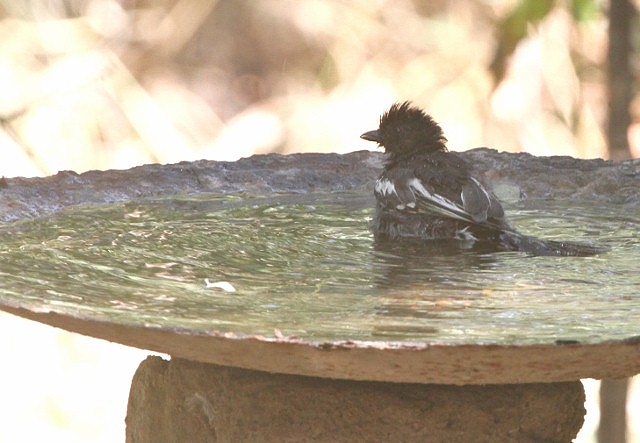
Female
 © Sharifa
© Sharifa
Male
Links:
Species text in The Atlas of Southern African Birds
Sabap2: http://sabap2.adu.org.za/spp_summary.ph ... §ion=3
Newman's birds of Southern Africa
Avian Leisure: CONFUSING BIRDS in NAMIBIA: BLACK TITS

Female
 © Sharifa
© SharifaMale
Links:
Species text in The Atlas of Southern African Birds
Sabap2: http://sabap2.adu.org.za/spp_summary.ph ... §ion=3
Newman's birds of Southern Africa
Avian Leisure: CONFUSING BIRDS in NAMIBIA: BLACK TITS
Kgalagadi lover… for ever
https://safrounet.piwigo.com/
https://safrounet.piwigo.com/
Ashy Tit
552. Ashy Tit Melaniparus cinerascens (Akasiagrysmees)
Order: Passeriformes. Family: Paridae
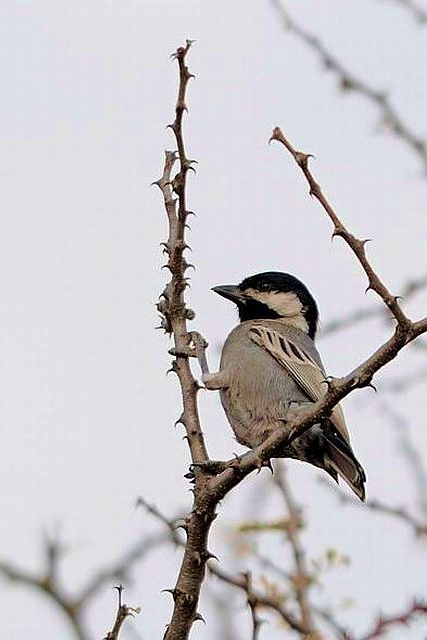 © Dewi
© Dewi
Description
Length 15 cm, weight 19-22 g.
Adult: Grey upper and underparts with black head and bib. White cheeks. Crown and lores to nape blue-black, hind neck white. Broad white band from the base of the bill to the sides of the neck. Mantle, back, and rump grey; flight feathers and primary coverts grey-black (brownish when worn) edged white to buff. Chin, throat, centre of breast and centre of belly black; flanks and sides of belly and breast grey. Bill black, eyes brown and legs and feet grey. The males and females are similar in both plumage and size.
Juvenile: duller, with duller browner cap that is more restricted.
Similar species: Differs from Grey Tit by its blue-grey (not brownish grey) back, and blue-grey (not buff) flanks and belly. It is darker than Miombo Tit, with less white in the wings.
Distribution
Central and northern areas of the sub-region. Near-endemic to southern Africa, occurring in the arid savannas woodlands of Botswana and the Kalahari Desert in South Africa and Namibia, extending marginally into south-western Angola. It also has a disjunct population in Zimbabwe, specifically in areas where the miombo (Brachystegia) woodland has been replaced with thorny woodland, thus displacing the Miombo tit. Most common in the central Kalahari.
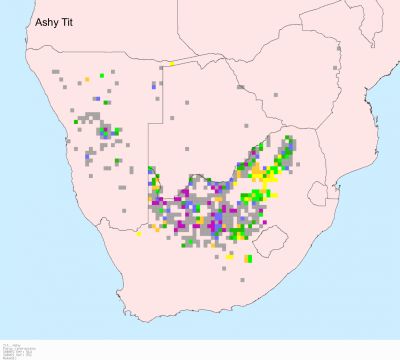
Habitat
Savanna & thornveld.
Diet
Mainly insects, especially caterpillars and beetles, to a lesser extent fruit and seeds. It forages in the tree canopy, sometimes rapidly pecking Acacia erioloba (Camel thorn) pods in search of seed parasites.
Breeding
Monogamous with nest helpers recorded at some nests. The nest is a thick pad built of animal hair and fine plant fibres, usually placed in either a natural tree cavity or an old barbet or woodpecker nest. It also has occasionally been recorded to nest in horizontal and vertical pipes. Egg-laying season peaks from October-December. It lays 3-6 eggs, which are incubated solely by the female for approximately 14-15 days. The eggs are white and may be speckled with red. The male brings her food once every hour or so, each visit involving both birds rapidly quivering their wings. During the first week of the chick's lives the female broods and feeds them with food given to her by the male at the nest entrance. Thereafter both sexes forage and give food to their young, who leave the nest at about 20-22 days old.
Parasitised by Greater Honeyguide.
Call
Easily distinguishable from Grey and Miombo tits by more liquid trill tlu-tlu-tlu-tlu and tutututututu-tuwee-tuwee-tuwee. Listen to Bird Call.
Status
Common resident.
Order: Passeriformes. Family: Paridae
 © Dewi
© DewiDescription
Length 15 cm, weight 19-22 g.
Adult: Grey upper and underparts with black head and bib. White cheeks. Crown and lores to nape blue-black, hind neck white. Broad white band from the base of the bill to the sides of the neck. Mantle, back, and rump grey; flight feathers and primary coverts grey-black (brownish when worn) edged white to buff. Chin, throat, centre of breast and centre of belly black; flanks and sides of belly and breast grey. Bill black, eyes brown and legs and feet grey. The males and females are similar in both plumage and size.
Juvenile: duller, with duller browner cap that is more restricted.
Similar species: Differs from Grey Tit by its blue-grey (not brownish grey) back, and blue-grey (not buff) flanks and belly. It is darker than Miombo Tit, with less white in the wings.
Distribution
Central and northern areas of the sub-region. Near-endemic to southern Africa, occurring in the arid savannas woodlands of Botswana and the Kalahari Desert in South Africa and Namibia, extending marginally into south-western Angola. It also has a disjunct population in Zimbabwe, specifically in areas where the miombo (Brachystegia) woodland has been replaced with thorny woodland, thus displacing the Miombo tit. Most common in the central Kalahari.

Habitat
Savanna & thornveld.
Diet
Mainly insects, especially caterpillars and beetles, to a lesser extent fruit and seeds. It forages in the tree canopy, sometimes rapidly pecking Acacia erioloba (Camel thorn) pods in search of seed parasites.
Breeding
Monogamous with nest helpers recorded at some nests. The nest is a thick pad built of animal hair and fine plant fibres, usually placed in either a natural tree cavity or an old barbet or woodpecker nest. It also has occasionally been recorded to nest in horizontal and vertical pipes. Egg-laying season peaks from October-December. It lays 3-6 eggs, which are incubated solely by the female for approximately 14-15 days. The eggs are white and may be speckled with red. The male brings her food once every hour or so, each visit involving both birds rapidly quivering their wings. During the first week of the chick's lives the female broods and feeds them with food given to her by the male at the nest entrance. Thereafter both sexes forage and give food to their young, who leave the nest at about 20-22 days old.
Parasitised by Greater Honeyguide.
Call
Easily distinguishable from Grey and Miombo tits by more liquid trill tlu-tlu-tlu-tlu and tutututututu-tuwee-tuwee-tuwee. Listen to Bird Call.
Status
Common resident.
Dewi
What is the good of having a nice house without a decent planet to put it on? (H D Thoreau)
What is the good of having a nice house without a decent planet to put it on? (H D Thoreau)
Ashy Tit Photos
552. Ashy Tit Melaniparus cinerascens
 © Dewi
© Dewi
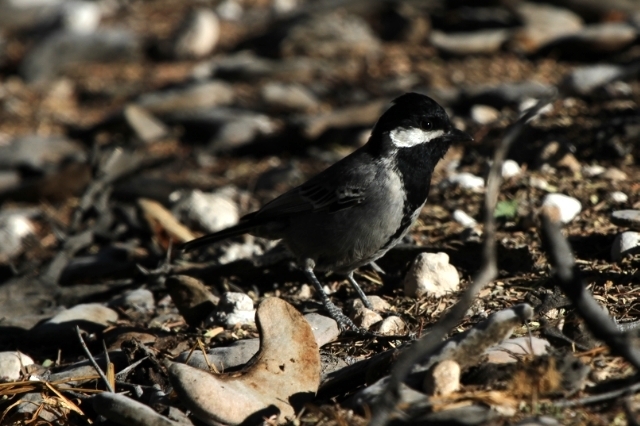 © Tina
© Tina
Kgalagadi Transfrontier Park, Mata Mata
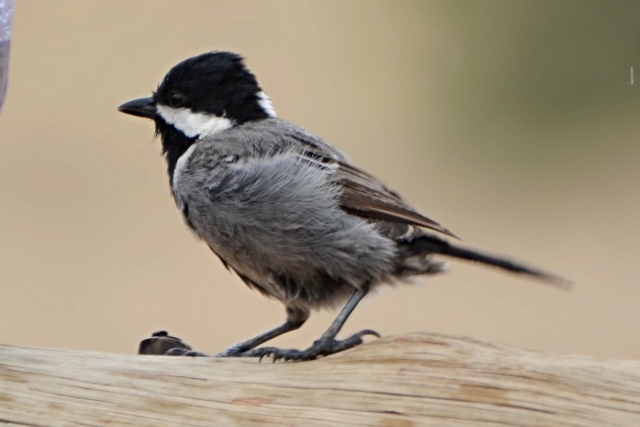 © Mel
© Mel
Kgalagadi Transfrontier Park, Grootkolk
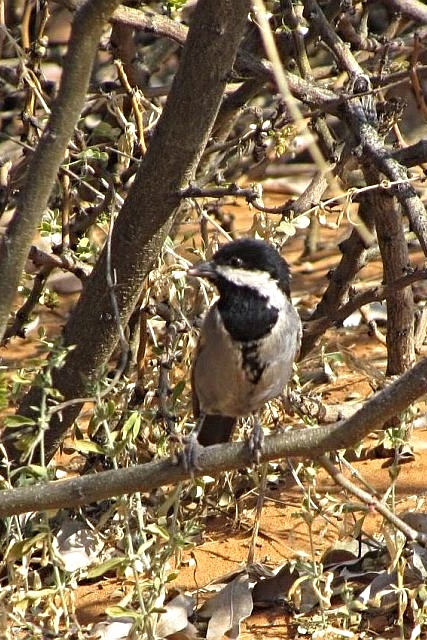 © puppy
© puppy
Links:
Species text in The Atlas of Southern African Birds
Sabap2
Newman's birds of Southern Africa
Simon Harrap. Tits, Nuthatches and Treecreepers
 © Dewi
© Dewi © Tina
© TinaKgalagadi Transfrontier Park, Mata Mata
 © Mel
© MelKgalagadi Transfrontier Park, Grootkolk
 © puppy
© puppyLinks:
Species text in The Atlas of Southern African Birds
Sabap2
Newman's birds of Southern Africa
Simon Harrap. Tits, Nuthatches and Treecreepers
Dewi
What is the good of having a nice house without a decent planet to put it on? (H D Thoreau)
What is the good of having a nice house without a decent planet to put it on? (H D Thoreau)


